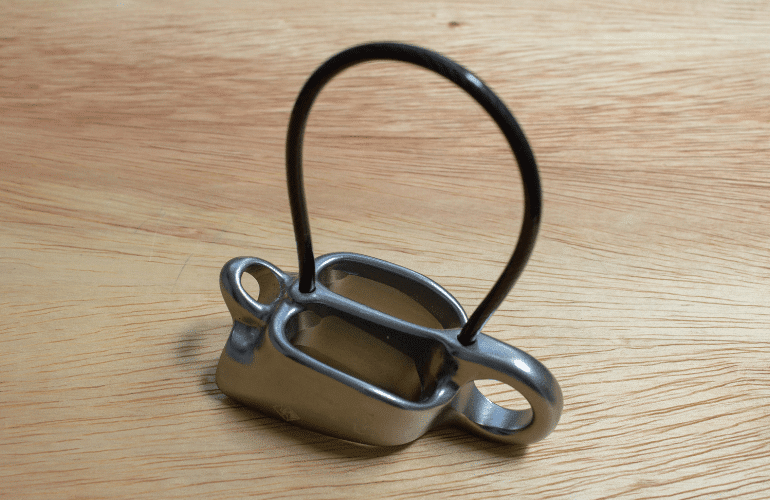Can you rappel with a belay device? This is a question people who are interested in rock climbing activities often ask. And a quick answer to this question is yes. You can rappel with different types of belay devices.
People often use names rappel devices and belay devices interchangeably as in most cases, devices used for belaying can be used for rappelling. However, the belay devices are safer to rappel with than rappel devices.
There are many different types of belay devices on the market today, with each boasting of different features, and we will talk about this shortly. When used correctly, belay devices make climbing rocks and ascending from them safe as they use friction to keep a climber from sliding.

Without this device, the person on the ground will have to hold the rope in their hands to keep the climber afloat. This would cause serious rope burns and result in ground falls. This is why belay devices are great for rappelling and rock climbing.
Let’s now talk about the main types of belay devices.
Types of Belay Devices for Rappelling
There are three main types of belay devices including;
1) Tubular Belay Devices for Rappelling
Also called ATC (air traffic controller), tubular belay devices are the most common types of belay devices that many of us know and love. They are suitable for different kinds of climbing, including gym climbing, traditional, sport, multi-pitch, rappelling, single-pitch, or sports.
Tubular devices feature two slots. When belaying, you insert a bent rope bright in one slot and then fasten a carabiner in the loop and attach the carabiner to your harness’s belay loop. Read our guide on how many carabiners you’ll need for rappelling.
The bent rope shape creates friction, which helps in stopping the rope. When used for rappelling, you insert the two rope strands through both slots,

Advantages of using tubular belay devices:
- They are compact and lightweight;
- Tubular belay devices can use ropes with varying diameters;
- Easy to use and thus good for beginners;
- It is pretty affordable;
- It is versatile as it can be used for all types of climbing including, gym, ice, sport, and multi-pitch.
Disadvantages of using tubular belay devices:
- The belayer can become fatigued, and this makes it not ideal for route-setting;
- You can find plenty of tubular belay devices on the market and get a little bit confused.
2) Assisted Braking Belay Devices for Rappelling
Also called auto-locking, self-locking, or auto-blocking devices, these belaying devices lockdown on a rope to help a belayer hold a fallen climber. They are available in two types; passive and active. Let’s discuss the two types briefly.

2.1) Passive assisted braking belay devices
These have no moving parts. They lock down the rope at the desired point by pinching it between the device and the carabiner.
Passive assisted braking devices tend to be better than their active counterparts because they are lightweight and are suitable for different kinds of climbing. In addition, they can be used to rappel when two strands of rope are attached to them.
2.2) Active assisted braking belay devices
These belay devices work by pinching the rope between the camming mechanisms built into them. They only use one strand of rope and thus cannot be used for rappelling.
These technologically advanced belay devices are ideal for belaying climbers who practice single-pitch sport routes as they tend to take some weight off the belayer. During multi-pitch climbs, these devices are used to lift off a second climber.
They are heavier than their passive counterparts due to the inbuilt camming mechanism. Another disadvantage of these belaying devices is that they cannot be used for rappelling.
3) Figure 8 Belay Devices for Rappelling
Generally used for rappelling and in rescue efforts, figure 8 belay devices can also be used for belaying. They are metallic and feature two slots- the top slot and the larger bottom slot.

Advantages of Figure 8 Belay Devices:
- They are the most affordable of the three types of belay devices;
- They accommodate ropes of varying diameters;
- The rope moves through it smoothly when rappelling.
Disadvantages of Figure 8 Belay Devices:
- They are not ideal for beginner belayer as the rope tends to move through quickly;
- They tend to twist the rope if you are not careful.
Final Thoughts
So, once again, can you rappel with a belay device?
Yes. Virtually any device you can use for belaying can be used for rappelling, as rappelling techniques are pretty similar to those of belaying.
Keep in mind that they are different types of belaying device you can use for rappelling, and thus you have to choose what works best for you.
Therefore, you may need to try different types before you decide on which one to buy. No matter the type you choose, make sure to get the proper training to be safe. Further, read and learn how to belay properly.
